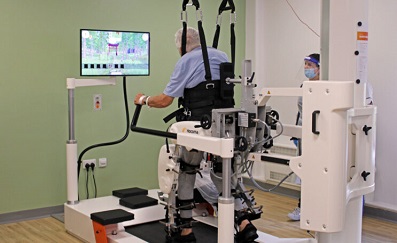What makes Summit Medical and Scientific stand out from the competition?
We often quote Lord Kelvin, creator of the Kelvin Scale: “If you can’t measure it, you can’t improve it.”
This is what helps Summit Medical and Scientific stand out – our expertise in biomechanics allows us to understand how important accurate measurement, assessment and physiologically correct movement is for rehabilitation.
We work with the best providers to achieve this standard, and Hocoma and Motek’s solutions allow patients to go even further.
Robotics allows for the functional intensive therapy necessary to establish new neural pathways, starting as early as possible.
Performance feedback and monitoring of progress with virtual reality game-like exercises makes therapy motivating and enjoyable. These are all key principles for physical rehabilitation based on clinical research.
Who are some of the organisations you have worked with?
We’re proud to work with some of the UK’s top facilities, including the Defence and National Rehabilitation Centre, Royal Bournemouth Hospital, BASIC, Morrello Clinic, The Wellington Hospital, Neural Pathways, Ascot Rehab as well as some new customers we can’t wait to announce soon.
What do you see as the greatest challenges your customers face in supporting stroke patients?
The “Right To Rehab” report did a fantastic job of shining a spotlight on the issues faced by the community in stroke recovery.
Despite the hard work of physiotherapists and occupational therapists, not everyone gets the rehabilitation they need after stroke. NICE recommends 45 minute sessions of each relevant stroke rehabilitation at least five days per week, but this target isn’t always reached.
The worldwide challenge is a rapidly ageing population and consequent increase in neurological disease – 1 in 6 people will have a stroke.
Customers face an increase in numbers of patients and health costs, and manual therapy is ill-equipped to cope. There is a limit to what can be done early and the intervention window is missed. There is also a lack of intensity and efficiency.
A Cochrane level review in 2017 found that a severe stroke patient improves their chance of walking again by 48% if physical therapy includes robotic training.
The follow up in 2020 found significant evidence that people suffering from stroke can improve their gait ability beyond what traditional therapy can do alone, and that people without the ability to walk, or who are within three months of injury benefitted the most.
How are you helping your customers meet these challenges?
Incorporating devices into clinical practice does require investment, but patient care is costly too and a faster recovery will reduce in-patient stay and pressure on the NHS. It also reduces the strain placed on therapists and allows for a more efficient set-up.
For example, the Hocoma Lokomat robotic gait trainer only requires one therapist to operate, freeing up staff. A patient might achieve a low number of steps during manual gait training, but in a session using the Lokomat, they can achieve hundreds or even thousands of steps in a safe environment.
Using several upper limb devices like the Hocoma ArmeoSpring can allow several patients to practice therapy exercises supervised by only one therapist.
What are your priorities for the months and years ahead?
Our priority has been raising awareness in the UK, not just what rehabilitation devices are available, but also the particular benefits of using Hocoma and Motek robotic and VR technology, such as physiologically correct, precise and guided movement, even before the patient is able to move themselves.
Our plans include organising demos and workshops and working with existing customers who are already experiencing the benefits and can pass on their success to others.
We’re also looking at different financing models so that we can support anyone interested in incorporating this technology into their practice.
How can readers find out more?
If you would like to get in touch, please feel free to call 01372 459863, email info@summitmedsci.co.uk, or visit our website. We are always happy to help.

